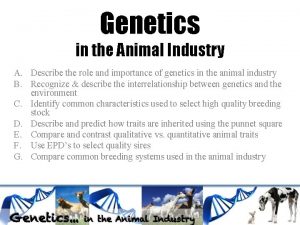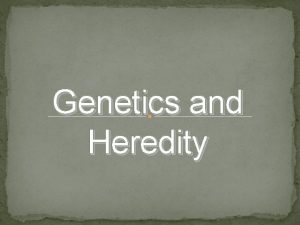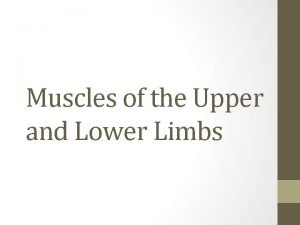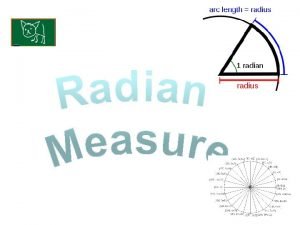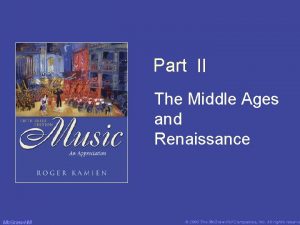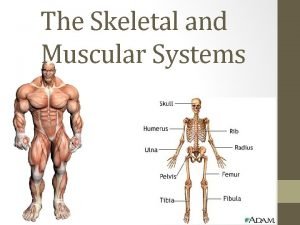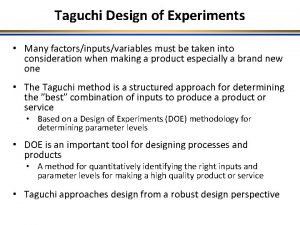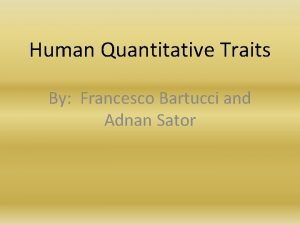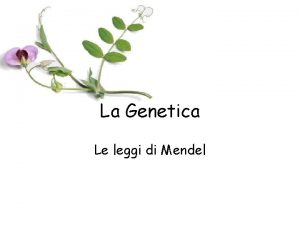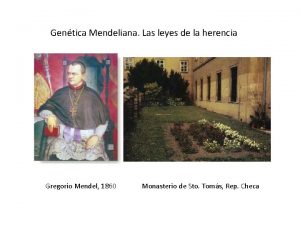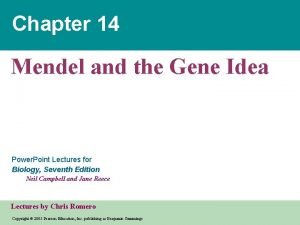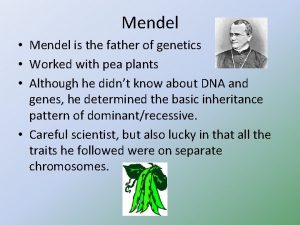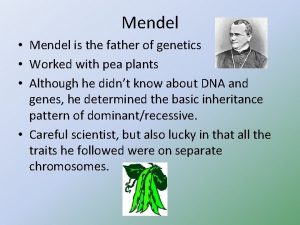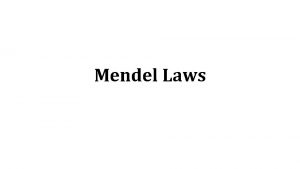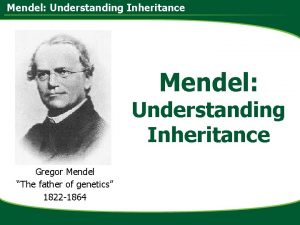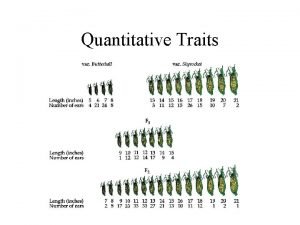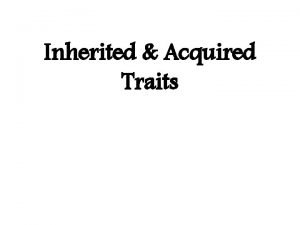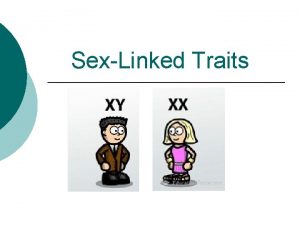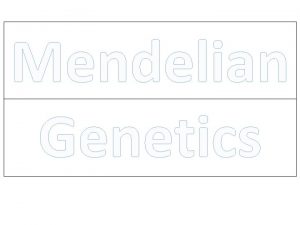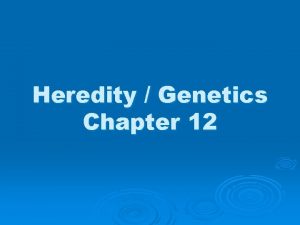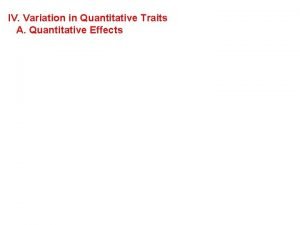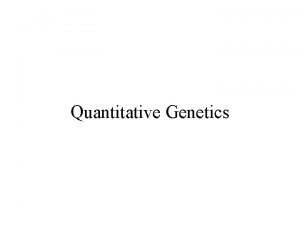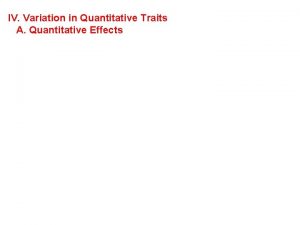Quantitative traits Quantitative Traits Mendel worked with traits



























- Slides: 27

Quantitative traits

Quantitative Traits • Mendel worked with traits that were all discrete, either/or traits: yellow or green, round or wrinkled, etc. Different alleles gave clearly distinguishable phenotypes. • Many traits don’t fall into discrete categories: height, for example, or yield of corn per acre. These are “quantitative traits”. • The manipulation of quantitative traits has allowed major increases in crop yield during the past 80 years. This is an important part of why today famine is rare. Until very recently, crop improvement through quantitative genetics was the most profitable aspect of genetics. • Early in the history of genetics was argued that quantitative traits worked through a genetic system quite different from Mendelian genetics. This idea has been disproved, and theory of

Qualitative versus quantitative traits Qualitative traits Quantitative traits 1 -Few genes Low environmental influence Distinct offspring classes Many genes Strong environmental influence Continous segregation

Quantitative trait § Qualitative traits: Discontinuous variation: § Quantitative trait: Continuous variation: The observed phenotype is the result of the genotype, the environment and the genotype x environment interactions.

Quantitative Traits • Traits that are genetically influenced but do not show single gene (Mendelian) patterns of inheraitance • Phenotypes (characteristics) that vary in degree and can be attributed to polygenic effects, i. e. , product of two or more genes, and their environment. • They are influenced by the combined action of many genes and are characterized by continuous variation. • . Examples: height, intelligence & hair color.

Types of Quantitative Trait 1. continuous trait: can take on any value: height, for example. 2. countable (meristic) can take on integer values only: number of bristles, for example. 3. threshold trait: has an underlying quantitative distribution, but the

Quantitative Traits are Caused by Mendelian Genes • In 1909 Herman Nilsson-Ehle from Sweden did a series of experiments with kernel color in wheat. • Wheat is a hexaploid, the result of 3 different species producing a stable hybrid. There are thus 3 similar but slightly different genomes contained in the wheat genome, called A, B, and D. • Each genome has a single gene that affects kernel color, and each of these loci has a red allele and a white allele. We will call the red alleles A, B, and D, and the white alleles a, b, and d. • Inheritance of these alleles is partially dominant, or “additive”. The amount of red pigment in the kernel is proportional to the number of red alleles present, from 0 to 6.

Wheat Kernel Color • • • The cross: AA BB DD x aa bb dd. Red x white. F 1: Aa Bb Dd phenotype: pink, intermediate between the parents. Now self these. F 2: alleles follow a binomial distribution: – – – – • • 1/64 have all 6 red alleles = red 6/64 have 5 red + 1 white = light red 10/64 have 4 red + 2 white = dark pink 15/64 have 3 red + 3 white = pink 10/64 have 2 red + 4 white = light pink 6/64 have 1 red + 5 white = very pale pink 1/64 have all 6 white = white Add a bit of environmental variation and human inability to distinguish similar shades: you get a quantitative distribution. This demonstrates that a simple Mendelian system: 3 genes, 2 alleles each, partial dominance--can lead to a quantitative trait.

More Wheat Kernel Color

Quantitative Traits • Quantitative traits = complex traits = Multifactorial • Multifactorial traits are determined by multiple genetic and environmental factors acting together • Most traits that vary in the population are complex traits • Genetic architecture of a complex trait = specific effects and combined interactions of all genetic and environmental factors

Principles of Quantitative Trait Inheritance • Quantitative traits are influenced by the combined effects of numerous genes. These are called polygenic or multifactorial traits. • The genes follow Mendelian laws of inheritance; however, multifactorial traits have numerous possible phenotypic categories. • Environmental influences the phenotypic

Statistics of Quantitative Traits Quantitative traits exhibit a continuous distribution of phenotypes, thus, they cannot be analyzed in the same manner as traits controlled by a few genes. Rather, quantitative traits are described in terms of statistical parameters.

Statistics of Quantitative Traits The two primary statistics used are the mean and the variance.

Statistics of Quantitative Traits An associated statistic that is also relevant is the standard deviation, because it is in the same units as the mean.

Statistics of Quantitative Traits The mean is the average value of the distribution. The graph on the right demonstrates two distributions with the same mean but different variances. Two distribution can have the same mean, but widely different shapes. A wide distribution suggests a large range of values, whereas, a narrow distribution occurs when the range of observed values is small. The variance is a measure of the variability of the distribution.

Statistics of Quantitative Traits A simple way to describe a distribution is in terms of its mean and its standard deviation. The mean ± one standard deviation encompasses ~66% of the distribution. Thus a larger standard deviation suggests that the distribution is wider than one with a smaller standard deviation. Furthermore, ~95% of the distribution is found within ± two standard deviations of the mean and ~99% of the distribution is found within ± three standard deviations. Quantitative genetics of ear length in corn Generation Standard Tom Thumb (P 1) BMS (P 2) F 1 Mean (cm) 16. 80 6. 63 12. 12 deviation (cm) 0. 816 1. 887 1. 519

Statistics of Quantitative Traits Several observations can be made from the example. 1. Even though the mean ear length of the BMS is smaller, the standard deviation is larger. This suggests that it is more variable than the long ear line. 2. Because the F 1 population is derived from two pure lines, it should be entirely homogeneous (all are heterozygotes). Thus all the variance associated with that population is environmental variance. 3. The mean of a quantitative trait in a F 1 population is intermediate to the two parents, and the mean of the F 2 is approximately equal to that of the F 1. 4. The F 2 population is more variable than the F 1. 5. The extreme values of the distribution should be equivalent to the two parents used in the cross because this small portion of the population will have the same genotypes as the parents. If

Variance Components of a Quantitative Trait The metric value (or phenotypic value) for a specific individual, is the result of genetic factors, environmental factors, and the environmental factors that interact with the genetic factors. The sum of these factors in a population of individuals segregating for a quantitative trait contributes to the variance of that population.

Variance Components of a Quantitative Trait The total variance can be partitioned in the following manner. VP = VG + VE + VGE Where, VP = total phenotypic variation of the segregating population VG = genetic variation that contributes to the total phenotypic variation VE = environmental contribution to the total phenotypic variation VGE = variation associated with the genetic and

Variance Components of a Quantitative Trait The genetic variation can be further subdivided into three components. 1. Additive genetic variation (VA) Some alleles may contribute a fixed value to the metric value of quantitative trait. 2. Dominant genetic variance (VD). In addition to genes which have an additive effect on the quantitative trait, other genes may exhibit a dominant gene action which will mask the contribution of the recessive alleles at the locus.

Variance Components of a Quantitative Trait 3. Interaction genetic variance (VI). This final type of genetic variance is associated with the interactions between genes. The genetic basis of this variance is epistasis, and it is called the interaction genetic variance (VI).

Variance Components of a Quantitative Trait The total genetic variance can be partitioned into the three forms of variance VG = VA + VD + VI The total phenotypic variance can be rewritten as VP = VA + VD + VI + VE + VGE

Heritability The proportion of observed different on a trait among individuals of a population that are due to genetic differences A measure of variance and is only meaningful for characteristics of a population (not the individual). 1. Broad-sense heritability proportion of phenotypic variance among individuals in a population that results from genetic differences. 2. Narrow-sense heritability proportion of phenotypic variance that results from additive genetic variance

Broad-Sense Heritability • Broad-sense heritability (H 2) includes all genetic effects combined H 2 = sg 2 / sp 2 = sg 2 / sg 2 + se 2 • Knowledge of heritability is useful in plant and animal breeding because it can be used to predict the magnitude and speed of population improvement 24

Narrow-Sense Heritability • Narrow-sense heritability (h 2) = proportion of the variance in phenotype that is transmissible from parents to offspring. The genetic variance can be split into both additive and dominant alleles. h 2 = sg 2 / sp 2 = sg 2 / sa 2 + sd 2 + se 2 • Narrow-sense heritability can be used to predict changes in the population mean in with individual selection h 2 = (M’ - M)/(M* - M) • In general, h 2 < H 2. They are equal only when the alleles affecting the trait are additive in their effects = heterozygous phenotype is exactly intermediate between homozygous dominant and recessive 25

Heritability 1. The heritability estimate is specific to the population and environment which is analyzed. 2. The estimate is a population, not an individual parameter. 3. Heritability does not indicate the degree to which a trait is genetic, it measures the proportion of the phenotypic variance that is the result of genetic factors.

The improvement of quantitative traits through conventional It is a long and difficult process Examples of efficient conventional selection 1) Reduction of glucosinolate rate of rapeseed grains 1977 : Jetneuf 100 moles/g 1983 : Darmor 25 moles/g 1989 : Samouraï 12 moles/g 2) Yield of irrigated rice in the Philippines 1920: Peta 1. 5 t/ha 1962: IR 8 5. 0 t/ha 1998: IR 72 10. 0 t/ha 2001: New plant type 12. 0 t/ha (This increase is not exclusively due to genetic progress)
 Qualitative traits vs quantitative traits
Qualitative traits vs quantitative traits Qualitative traits vs quantitative traits
Qualitative traits vs quantitative traits Qualitative traits vs quantitative traits
Qualitative traits vs quantitative traits Gregor mendel video
Gregor mendel video Mendel
Mendel Linkers for conditionals
Linkers for conditionals Prime mover of arm extension
Prime mover of arm extension Guillaume de machaut worked primarily in
Guillaume de machaut worked primarily in 1. what was the ghazu? what was the ummah?
1. what was the ghazu? what was the ummah? Into reported speech
Into reported speech Sector perimeter
Sector perimeter How feudalism worked
How feudalism worked Worked out
Worked out Josquin desprez was a contemporary of
Josquin desprez was a contemporary of Flood routing
Flood routing How the body works answer key
How the body works answer key Essays that worked johns hopkins
Essays that worked johns hopkins She worked hard. she made herself ill
She worked hard. she made herself ill I stumbled in his hobnailed wake
I stumbled in his hobnailed wake Worked out
Worked out Chemsheets as 1044
Chemsheets as 1044 Dominant genetic variance
Dominant genetic variance Inheritance of quantitative traits
Inheritance of quantitative traits Mendel genetica
Mendel genetica Cruza dihibrida
Cruza dihibrida Who was mendal
Who was mendal Chapter 14: mendel and the gene idea
Chapter 14: mendel and the gene idea Al cruzar una planta de guisantes de flores purpura
Al cruzar una planta de guisantes de flores purpura


